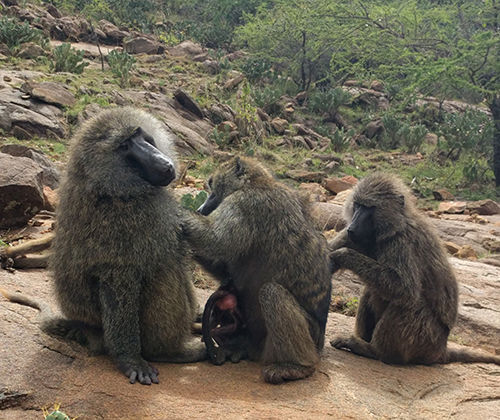ASU study reveals 'work-life balance' for baboons

A male olive baboon caring for an infant. Photo courtesy Joan Silk/ASU
Dozens of books and websites offer advice about how to achieve a satisfying work-life balance. People seek this advice because they have too much to do and too little time to do it.
New research published this week by Arizona State University researchers in iScience shows that humans are not the only creatures that have to balance conflicting demands — male olive baboons also make trade-offs between mating and parenting.
Male olive baboons devote a lot of time and energy to competing for access to sexually receptive females. They follow them around, try to exclude rival males and try to mate. The more time they spend near females around the time of conception, the more likely they are to sire infants.
But these same males also invest time and energy in relationships with particular nursing females, who are often the mothers of their offspring. These relationships, which researchers call “primary associations,” provide females and their offspring with protection and are the foundation of lasting ties between males and their offspring.
ASU researchers Caitlin Hawley, Sam Patterson and Joan Silk analyzed four years of data on two groups of wild olive baboons to find out whether males’ involvement in primary associations limited their involvement in competition over access to sexually receptive females. They were able to do this by measuring the number of primary associations that males were involved in at a given time, which varied from zero to five.
They discovered that males that were involved in more primary associations at a given time devoted less time to pursuing sexually receptive females than other males did. They also found that males that had more primary associates on a given day had a bit more difficulty juggling their relationships with their partners.
Although researchers have known for a long time that male baboons compete over access to females and that males also form close ties to nursing females, previous work had not investigated whether these activities were compatible.

Baboons, shown grooming each other, are highly social. Photo courtesy Joan Silk/ASU
“Our results show that males can’t have it all; they have to make trade-offs,” said Silk, who is a research associate with the Institute of Human Origins and a Regents Professor with the School of Human Evolution and Social Change.
“Although baboons are very different than modern humans, the environments that baboons live in now is similar to the environment in which humans evolved. Our results may help us (with) understanding the dynamics (of) mating and parenting in the evolutionary history of our own species," said Hawley, the lead author of the paper and a graduate student with the School of Human Evolution and Social Change.
According to Patterson, a PhD graduate from ASU and postdoctoral researcher at New York University, the study also raises questions about the complex web of costs and benefits that parents and infants must navigate together.
“How do males, females and infants benefit from primary associations?" Patterson said. "Do these relationships help infant baboons grow faster or live longer?”
This work hopes to address these questions and more, and to gain new insight into the relative magnitude of the benefits males gain from mating and parenting.
In the study, there was some evidence that males that were involved in more primary associations also sired fewer infants than expected based on their dominance rank — though more data is needed to know whether this effect is robust.
More Science and technology

Applied Materials invests in ASU to advance technology for a brighter future
For nearly 60 years, global giant Applied Materials has been hard at work engineering technology that continues to change how…

Meet ASU engineering students who are improving health care, computing and more
Furthering knowledge of water resource management, increasing the efficiency of manufacturing point-of-care health diagnostic…

Turning up the light: Plants, semiconductors and fuel production
What can plants and semiconductors teach us about fuel production?ASU's Gary Moore hopes to find out.With the aim of learning how…

